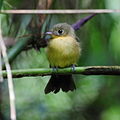| Myiobius | |
|---|---|
 | |
| Black-tailed myiobius (Myiobius atricaudus) | |
| Scientific classification | |
| Kingdom: | Animalia |
| Phylum: | Chordata |
| Class: | Aves |
| Order: | Passeriformes |
| Family: | Onychorhynchidae |
| Genus: | Myiobius Gray, GR, 1839 |
| Type species | |
| Muscicapa barbata Gmelin, JF, 1789 | |
Myiobius is a genus of passerine birds in the family Onychorhynchidae. [1] The genus was previously considered to belong to the Tyrannidae or Tityridae.
The genus Myiobius was erected in 1839 by George Robert Gray in the section on birds in The Zoology of the Voyage of H.M.S. Beagle under the Command of Captain Fizroy R.N., during the years 1832-1836. [2] [3] The type species is the whiskered myiobius. [4]
The genus contains four species: [1]
| Image | Scientific name | Common name | Distribution |
|---|---|---|---|
 | Myiobius villosus | Tawny-breasted myiobius | Bolivia, Colombia, Ecuador, Panama, Peru, and Venezuela |
 | Myiobius sulphureipygius | Sulphur-rumped myiobius | Belize, Colombia, Costa Rica, Ecuador, Guatemala, Honduras, Mexico, Nicaragua, and Panama |
 | Myiobius barbatus | Whiskered myiobius | Brazil, Colombia, Ecuador, French Guiana, Guyana, Peru, Suriname, and Venezuela |
 | Myiobius atricaudus | Black-tailed myiobius | Brazil, Colombia, Costa Rica, Ecuador, Panama, Peru, and Venezuela. |
